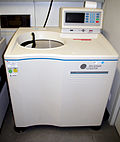Ultracentrifuge
Ultracentrifuge[edit]
An ultracentrifuge is a type of centrifuge that operates at very high speeds, capable of generating accelerations as high as 1,000,000 g (9,800 km/s_). Ultracentrifuges are used in a variety of scientific fields, including molecular biology, biochemistry, and polymer science, to separate particles of different densities or to purify molecules such as proteins, nucleic acids, and viruses.

History[edit]
The concept of the ultracentrifuge was first developed by Theodor Svedberg in the early 20th century. Svedberg's work on the ultracentrifuge earned him the Nobel Prize in Chemistry in 1926 for his research on colloids and macromolecules. The first practical ultracentrifuge was built in the 1920s, and since then, the technology has evolved significantly.
Types of Ultracentrifuges[edit]
Ultracentrifuges are generally classified into two main types: analytical and preparative.
Analytical Ultracentrifuge[edit]
The analytical ultracentrifuge is used to study the properties of macromolecules. It allows scientists to determine the molecular weight, sedimentation coefficient, and diffusion coefficient of particles. The analytical ultracentrifuge is equipped with optical systems that enable the observation of the sample during centrifugation.
Preparative Ultracentrifuge[edit]
The preparative ultracentrifuge is used to separate and purify particles based on their size, shape, and density. It is commonly used in the purification of biological macromolecules and subcellular organelles.
Applications[edit]
Ultracentrifuges are essential tools in the field of biotechnology and biomedical research. They are used in the isolation of DNA, RNA, and proteins for various applications, including genetic engineering and drug development. In virology, ultracentrifuges are used to purify viruses and viral particles.
Operation[edit]
Ultracentrifuges operate by spinning samples at very high speeds, creating a strong centrifugal force that causes particles to sediment at different rates based on their size and density. The rotor, which holds the samples, is a critical component of the ultracentrifuge and must be carefully balanced to prevent damage to the machine.

Safety Considerations[edit]
Due to the high speeds and forces involved, ultracentrifuges require careful handling and maintenance. Proper training and adherence to safety protocols are essential to prevent accidents and equipment damage.
Related Pages[edit]
References[edit]
- Svedberg, T. (1926). "The Ultracentrifuge". Nobel Lecture.
- Beckman Coulter, Inc. "Ultracentrifuges: A Guide to Operation and Safety".
Ultracentrifuge[edit]
-
Beckman Coulter Ultracentrifuge XL-100K
-
Beckman Model E Ultracentrifuge
Ad. Transform your life with W8MD's Budget GLP-1 injections from $75


W8MD offers a medical weight loss program to lose weight in Philadelphia. Our physician-supervised medical weight loss provides:
- Weight loss injections in NYC (generic and brand names):
- Zepbound / Mounjaro, Wegovy / Ozempic, Saxenda
- Most insurances accepted or discounted self-pay rates. We will obtain insurance prior authorizations if needed.
- Generic GLP1 weight loss injections from $75 for the starting dose.
- Also offer prescription weight loss medications including Phentermine, Qsymia, Diethylpropion, Contrave etc.
NYC weight loss doctor appointmentsNYC weight loss doctor appointments
Start your NYC weight loss journey today at our NYC medical weight loss and Philadelphia medical weight loss clinics.
- Call 718-946-5500 to lose weight in NYC or for medical weight loss in Philadelphia 215-676-2334.
- Tags:NYC medical weight loss, Philadelphia lose weight Zepbound NYC, Budget GLP1 weight loss injections, Wegovy Philadelphia, Wegovy NYC, Philadelphia medical weight loss, Brookly weight loss and Wegovy NYC
|
WikiMD's Wellness Encyclopedia |
| Let Food Be Thy Medicine Medicine Thy Food - Hippocrates |
Medical Disclaimer: WikiMD is not a substitute for professional medical advice. The information on WikiMD is provided as an information resource only, may be incorrect, outdated or misleading, and is not to be used or relied on for any diagnostic or treatment purposes. Please consult your health care provider before making any healthcare decisions or for guidance about a specific medical condition. WikiMD expressly disclaims responsibility, and shall have no liability, for any damages, loss, injury, or liability whatsoever suffered as a result of your reliance on the information contained in this site. By visiting this site you agree to the foregoing terms and conditions, which may from time to time be changed or supplemented by WikiMD. If you do not agree to the foregoing terms and conditions, you should not enter or use this site. See full disclaimer.
Credits:Most images are courtesy of Wikimedia commons, and templates, categories Wikipedia, licensed under CC BY SA or similar.
Translate this page: - East Asian
中文,
日本,
한국어,
South Asian
हिन्दी,
தமிழ்,
తెలుగు,
Urdu,
ಕನ್ನಡ,
Southeast Asian
Indonesian,
Vietnamese,
Thai,
မြန်မာဘာသာ,
বাংলা
European
español,
Deutsch,
français,
Greek,
português do Brasil,
polski,
română,
русский,
Nederlands,
norsk,
svenska,
suomi,
Italian
Middle Eastern & African
عربى,
Turkish,
Persian,
Hebrew,
Afrikaans,
isiZulu,
Kiswahili,
Other
Bulgarian,
Hungarian,
Czech,
Swedish,
മലയാളം,
मराठी,
ਪੰਜਾਬੀ,
ગુજરાતી,
Portuguese,
Ukrainian

